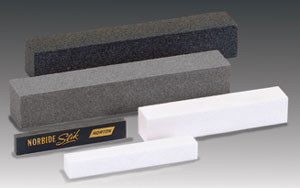The objective of dressing the wheel is to
True the wheel by knocking abrasive particles from the wheel's surface and making the wheel concentric.
This minimizes vibration and improves surface finish, eliminating the vibration of the out-of-balance
wheel across the workpiece's surface.
Dislodge these same abrasive particles, which also has the effect of exposing fresh abrasive from the
wheel's surface. Each abrasive grain is a small cutting tool; a worn grain has its edges dulled and
loses its effectiveness. Exposing the fresh grains is thus a sharpening process. Glazing of the wheel
is evidence of rounded grains and is noticeable by a reflective surface on the spinning wheel.
Clean the wheel. If a workpiece is softer than the grade for which the wheel is designed, the abrasive
particles will not be dislodged in time to present fresh, sharp grains. The wheel therefore appears to
lose its edge especially as the pores between grains fill with fragments of the workpiece. The wheel
is then said to be loaded and is one reason why the selection of wheel is extremely important.
They are available as
-
Star dresser: A long handled tool with a row of free running, hardened and
serrated, discs running at right angles to the handle. These are presented to the grinding wheel as it
is turned off and slows down. Force is applied to the face of the slowing wheel with the result that
the hardened discs match speed with the face of the wheel allowing the fingers or undulating surface of
the dresser, to knock the abrasive grains out.
-
Diamond dresser:
Shorter handled Diamond tools that either have a matrix of small
diamonds bonded to a broad surface on the end of the dresser (top image) or a single diamond mounted
in their face (lower image). As the diamond is introduced to the wheel's face, the harder diamond
survives the contest and the looser grains fall away.
Dressing stick:
A stick of hard material, usually made from the same materials (silicon carbide) but with a stronger
bonding agent.
The simplest and basic dressing process is to use a white aluminum oxide dressing stick. Maximum
exposure is necessary to optimize the wheel performance. Because of the many grades of carbides,
ceramics and other hard materials, the grinding process does not always allow the wheel to stay open
and exposed.
Generally, an aluminum oxide stick is used for dressing polyimide, resin, and some vitrified bonded
wheels. Silicon carbide sticks are used on metal, some vitrious-metal, and vitrified bonded wheels.
|



